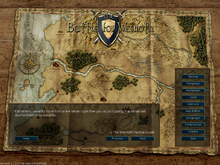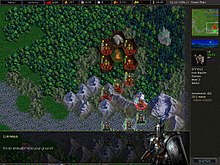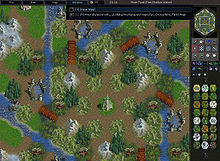The Battle for Wesnoth
| The Battle for Wesnoth | |||
|---|---|---|---|
| Studio | David White et al. a. | ||
| Erstveröffent- lichung |
October 2, 2005 | ||
| platform | GNU / Linux , macOS , Windows , AmigaOS 4, BeOS , FreeBSD , OS / 2 , ZETA , iOS | ||
| genre | Turn-based strategy game | ||
| Subject | Fantasy | ||
| Game mode | Single player, multiplayer via LAN and Internet | ||
| control | mouse | ||
| medium | Download | ||
| language | Multilingual | ||
| Current version | 1.14.11 | ||
| Age rating | |||
The Battle for Wesnoth ( Engl. "The battle for Wesnoth") is a free turn-based strategy video game , under the GNU General Public License has been released.
The player is presented with an isometric landscape with a hexagonal grid , which is characterized by trees, villages, meadows, caves and desert landscapes, on which the warriors move as hand-drawn pixel animations. The scenery and the framework are based on a fantasy world, which, together with the basic peoples ( elves , orcs, etc.), is roughly based on The Lord of the Rings and The Black Eye .
The game contains several elaborate campaigns with epic narratives that accompany the game. In addition to the main campaigns, a large number of other campaigns can be accessed via an update server accessible from the game.
Although the game is designed for single player mode , it can also be used for multiplayer games via LAN , hot seat mode or the Internet . Battle for Wesnoth is available in many languages. At least for the stable version there is a complete German translation, which sometimes has errors.
Battle for Wesnoth is considered one of the flagships of open source games with a large community worldwide and outstanding feature-completeness.
game
Essentially, it's about fighting one or more opponents and occupying villages, which bring in the game's only resource, gold . The gold is used to pay maintenance for existing units, to recruit new units and to recall units from previous missions, the latter only being possible while a campaign is being played. You are victorious when the specified game mission, in which the opponent must be defeated, for example , or the individual campaign or round goal is achieved (for example, the survival of the protagonists or the decimation of a certain number of enemy units).
struggle
In combat, it is important to know the advantages and disadvantages of your own units in relation to the enemy units, the terrain and the time of day and to use them accordingly.
Units gain experience in combat and thus advance in a level system and acquire better properties. They have life points, which are openly displayed, as well as precisely defined attack and hit probabilities, so that an exact calculation of the probability of the outcome of the fights is possible, which is calculated and displayed for the player.
The movement points (abbreviated as "BP" in the unit description) indicate how many spaces a unit can move in one round. All values are influenced in a specific game situation by factors such as terrain, resistances and neighboring units. A tutorial and a help system support beginners in learning the game.
Parties
Battle for Wesnoth currently distinguishes six parties in the multi-player mode by default, which can be either enemy, friend or yourself. Campaigns can in principle allow units of any parts or combinations of these parties for the player and the opponent, some unit types are also only available in campaigns or are used there by the opponents. (In the original campaign, "The Heir to the Throne", for example, you initially play with elves, later also with various human and dwarf units against different opponents, mainly loyalists, orcs and undead, depending on the scenario.)
- The rebels are mostly made up of elven units, with Ent- like trees, mermen, and human magicians . Many of their starting units have melee and ranged weapons, which makes them versatile. Elves are neutral towards the time of day and night and have high defensive powers in forests. On other terrain they are usually faster, but weaker than other units.
- The Knalgan Alliance consists of slow but resilient dwarves with strong melee attack , allied with human outlaws who can fight better under the guise of night. In general, dwarfs gain high defensive power when they occupy hills or mountains. Dwarfs can also move around caves better than any other unit and are day and night neutral. In the open, they are easily vulnerable to attack, while their human allies have a defensive bonus in the same field, but especially in forests.
- The Loyalists : Includes the human cavalry , magicians, and infantry who usually fight best during the day. They are the most diverse party, with more units than any other party except the Knalgan Alliance.
- The Nordmannen ("Northerner"), a party of orcs and goblins , accompanied by trolls and Naga warriors. Their focus is on cheap recruitment, brute force and hand-to-hand combat , and they fight best at night. Most units require few experience points to level up, their mobility is greatest on hills.
- The undead (along with human black magicians and bats) are sensitive to fire, thrust weapons and arcane attacks, but have a high resistance to swords, stabbing weapons and especially cold attacks. They trust easy access to magic and poison attacks. Some units have the ability to feed on their opponents' health to replenish their own, and most units are immune to poisoning. In contrast to the other races, most of the undead have no character traits and no individual names.
- The Draken ("Drakes") are a dragon-like breed that fights better during the day. Most can fly and spit fire. Their allies, the Saurians , are fast runners (sometimes faster than the Draken), prefer the night and defend themselves better in the marshland. What they have in common is their strong sensitivity to cold. Draken are the most maneuverable party, but their size makes them vulnerable to attack on any terrain.
Development history
According to his own statements, David White started developing the game in 2003 and was mainly inspired by the game Master of Monsters . He used the KISS principle as an essential design philosophy .
More developers later joined the project, and by May 2007 the list of contributors displayed in the game had nearly 400 entries. Relatively well-known authors from the open source scene also participate in the development of the game, such as the co-founder of the open source initiative Eric S. Raymond or the Linux kernel programmer Rusty Russell .
Modification options
In addition to the possibility of editing the free source code, Wesnoth also offers beginners extensive possibilities of modification: With the map editor you can create your own battlefields. Without extensive programming knowledge, you can also create your own units in the Wesnoth Markup Language (WML). Advanced users can use this markup language and Lua to program scenarios or campaigns and to modify the AI. The published work of many programmers can be integrated into the game as add-ons .
These add-ons are partly normal campaigns or scenarios, but some also offer completely new concepts: There are a number of different RPG scenarios that further deal with character upgrading (the most common is probably survival extreme ). Completely new systems of units are also being created. However, these add-ons are only partially translated.
music
Web links
- Official website (English)
- Article by LinuxUser about Wesnoth
- eComStation and OS / 2 porting (English)
Individual evidence
- ↑ Credits - Wesnoth. Retrieved October 2, 2013 .
- ↑ Wesnoth 1.14.11: Maintenance Release , accessed 1.5.2020
- ↑ Battle for Wesnoth 1.12 Has Big New Features , TuxArena November 27, 2014, accessed December 4, 2015
- ↑ Wesnoth Philosophy - Wesnoth. Retrieved October 2, 2013 .
- ↑ Developer entry for Eric S. Raymond ( Memento of the original from March 12, 2010 in the Internet Archive ) Info: The archive link was automatically inserted and has not yet been checked. Please check the original and archive link according to the instructions and then remove this notice. on gna.org
- ↑ Developer entry for Rusty Russel ( Memento of the original from May 17, 2011 in the Internet Archive ) Info: The archive link was automatically inserted and not yet checked. Please check the original and archive link according to the instructions and then remove this notice. on gna.org
- ↑ Video (in English) with a lecture by Rusty Russell at the Australian Linux conference linux.conf.au 2007 ( OGG ; 78.2 MB) about his work on Wesnoth, from here




